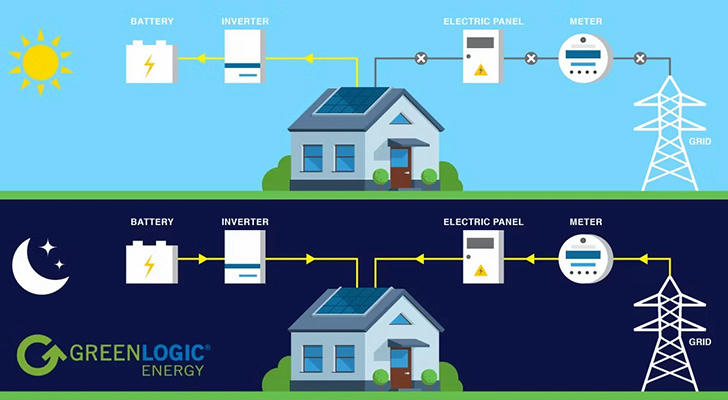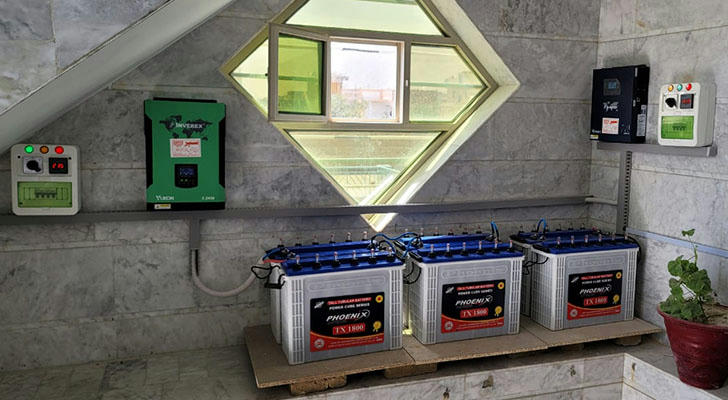☀️ Solar Energy Storage Batteries: The Invisible Money Saving Powerhouse for Future Home Electricity
At a time when energy prices are rising and power outages are frequent, more and more families are beginning to consider upgrading their solar power generation systems to a more "intelligent" version - adding solar batteries (Solar Battery). This is not just a power storage device, it is more like an "energy manager" for your home: it helps you store electricity during the day and automatically releases it at night; it can come to the rescue during power outages and help you fight against rising electricity prices.

🔋 What is a solar battery?
A solar battery is a device that stores solar power. Used with photovoltaic solar panels, it can store excess electricity during the day for use at night or during power outages.
You can think of it as a "backup bank" for household electricity use, with energy available at any time, intelligent distribution, and money-saving and peace of mind.
💡 What is it for? The role is clear at a glance:
✅ 1. No need to pay for electricity at night
Solar panels generate electricity during the day, and batteries store electricity. At night, you no longer rely on the power grid for electricity, and your electricity bill is greatly reduced.
✅ 2. Continue to supply power during power outages
In extreme weather or power grid failures, solar batteries can immediately enable backup power mode to provide continuous power for refrigerators, networks, medical equipment, etc.
✅ 3. Fight against rising electricity prices
As the average electricity price in the United States rises year by year, self-generation and self-use, storage and reuse have become the key to saving money for many families.
✅ 4. Participate in "virtual power plants" to make money
In some states, such as California, users can participate in the virtual power plant (VPP) program by selling the electricity in the battery to the power grid, and earn hundreds of dollars extra each year.
💰 Estimated Savings from Solar Batteries
| Savings Item | Estimated Range |
|---|---|
| Annual electricity bill savings | $300 – $1,000+ |
| Indirect losses avoided from power outages | $100 – $1,000+ (per event) |
| Virtual Power Plant (VPP) income | $100 – $400 / year |
| Total savings over 10 years | $3,000 – $10,000+ |
With the federal government's 30% solar tax subsidy, solar battery installation costs have become more cost-effective.
Why buy now?
According to new information released by the Internal Revenue Service (IRS), if you install qualifying clean energy equipment for your primary residence between 2022 and 2032, you may be eligible for the Residential Clean Energy Grant.
🔋 Tax Subsidy Overview
- Subsidy ratio: 30% of the cost of installing a new eligible device.
- Gradual decline: The credit rate drops to 26% for equipment placed in service in 2033 and 22% for equipment placed in service in 2034.
- Eligible equipment: including solar panels, solar water heaters, wind turbines, ground source heat pumps, fuel cells and battery energy storage technology (starting in 2023).
- Ineligible equipment: Used equipment is not eligible.
- Subsidy Type: It is non-refundable, meaning the subsidy cannot exceed the tax you owe, but unused subsidies can be carried forward to future years.
🏠 Eligibility
- Primary residence: Whether you are a homeowner or a tenant, as long as it is your primary residence, you are eligible.
- Equipment installation: The subsidy must be claimed in the tax year the equipment is placed in service, not just the year it was purchased.
- Form submission: When you file your tax return, you will need to complete and submit a form to claim the subsidy.
🔋 Price comparison table of different solar battery models
| Model combination | Total capacity (kWh) | Total price (USD) | Average unit price ($/kWh) | Applicable scenarios |
|---|---|---|---|---|
| SLR100 | 1.2 | $149.99 | $125.00 | Portable, RV, camping, emergency power supply |
| 4 × SLR155 | ~6.2 | $1,199.93 | ~$193.53 | Small residential solar energy storage |
| 4 × SLR200 | ~9.6 | $1,799.95 | ~$187.49 | Medium and large solar/wind energy storage |
| 6 × SLR125 | ~9 | ~$1,499.94 | ~$166.66 | Medium energy storage, RV, backup power system |
| 8 × SLR125 | ~10 | $1,999.95 | $200.00 | Large home energy storage system, off-grid power supply |
The above data comes from Amazon
🎯 Selection suggestions (based on daily household electricity consumption):
| Average daily electricity consumption | Recommended battery capacity |
|---|---|
| <5 kWh | 5 kWh (emergency) |
| 5–10 kWh | 10 kWh |
| 10–20 kWh | 15 kWh |
| >20 kWh | 20 kWh+ |
🏆 List of mainstream brands in the market
| Brand | Model | Capacity range (kWh) | Features |
|---|---|---|---|
| Tesla Powerwall | Powerwall 3 | 13.5 kWh | Intelligent management, remote control, grid connection support |
| Enphase | Encharge series | 3.4–10.5 kWh | Modular, easy to expand |
| LG Energy | RESU series | 9.8–16 kWh | High energy density, long life |
| Sonnen | ecoLinx series | 10–30+ kWh | High-end market, made in Germany |
🧮 Is it suitable for your installation?
✅ Recommended installation crowd:
- Having a solar system, want to increase the self-use rate
- Living in areas with power outage risk or large time-of-day differences in electricity prices (such as California, Texas)
- High electricity consumption, electric cars, no one at home during the day
- Families planning to live for a long time, focusing on energy conservation and power independence
❌ Not suitable for people:
- Using very little electricity, the electricity bill is low in itself
- Frequently moving or renting, not wanting to invest for a long time
📦 Conclusion: Not "spare", but "necessary"
Solar batteries are no longer a "optional" option, but a core device to achieve family energy independence, protect the stability of daily life, and fight against rising electricity prices.
If you are using solar energy, or are considering installing solar energy, then adding batteries will help you achieve a leap from "saving money on power generation" to "freedom of electricity use".

